Content
All issues / Volume 16 (2022) / Issue 6 (June)
Markus Gahleitner
Vol. 16., No.6., Pages 557-557, 2022
DOI: 10.3144/expresspolymlett.2022.41
Vol. 16., No.6., Pages 557-557, 2022
DOI: 10.3144/expresspolymlett.2022.41
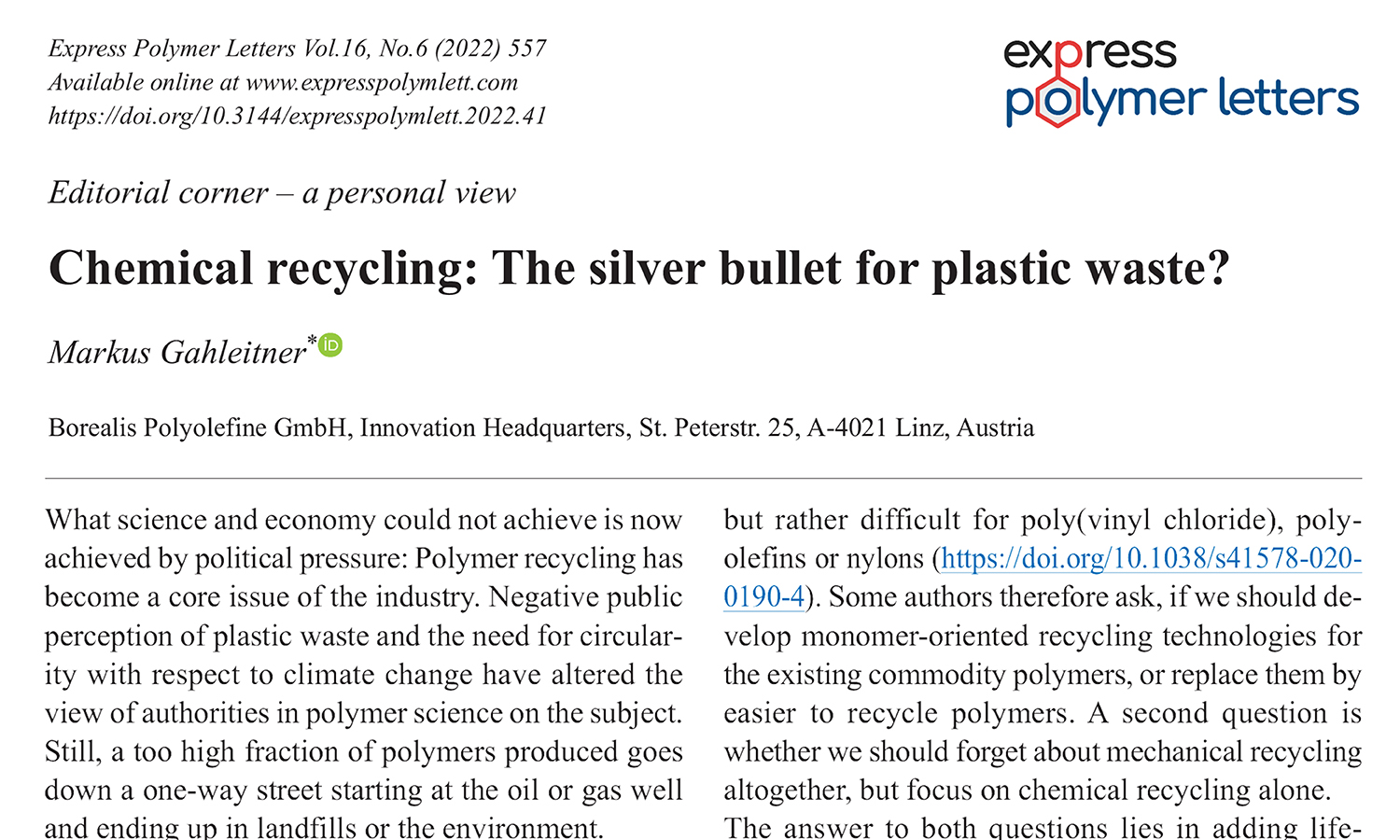
This is an editorial article. It has no abstract.
Sajith Thottathil Abdulrahman, Bindu Patanair, Vineeth Puthuparampil Vasukuttan, Sabu Thomas, Emmanuel Cadel, Fabien Cuvilly, Allisson Saiter-Fourcin, Zakiah Ahmad, Maciej Jaroszewski, Michal Strankowski, David Laroze
Vol. 16., No.6., Pages 558-572, 2022
DOI: 10.3144/expresspolymlett.2022.42
Vol. 16., No.6., Pages 558-572, 2022
DOI: 10.3144/expresspolymlett.2022.42
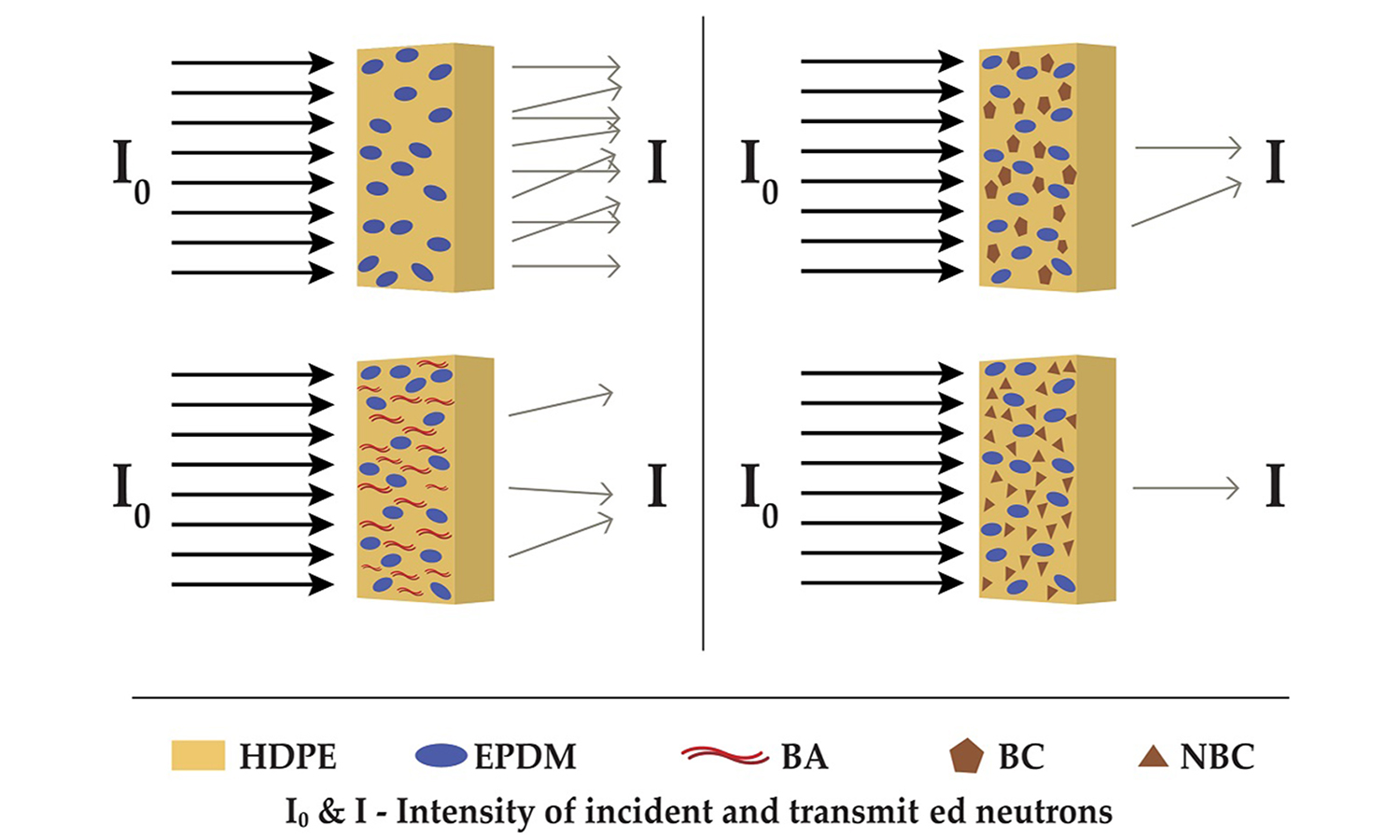
Novel materials with neutron shielding property were fabricated by incorporating boron compounds into highdensity polyethylene (HDPE)/Ethylene propylene diene monomer rubber (EPDM) blends. A detailed investigation on the morphological, thermal, mechanical, and neutron attenuation properties of suitable proportion of HDPE/EPDM blend with boric acid (BA), boron carbide (BC), and nano boron carbide (NBC) were performed. Morphology of the 20 wt% of EPDM shows better distribution in HDPE matrix. BA filler is localised in the HDPE phase, while NBC shows uniform distribution in HDPE/EPDM blend compared to its micro counterpart. There is a reduction in the tensile strength and modulus with the incorporation of EPDM in HDPE, whereas the ductility of HDPE is enhanced. A significant increase in the tensile toughness of the HDPE/EPDM blend with lower tensile strength and modulus is observed for BA, and BC filled composites. Moreover, HDPE/EPDM composites with NBC show only a marginal increase in the tensile toughness, tensile strength, and modulus. Comparison of the Young’s modulus of the HDPE/EPDM blends with theoretical models indicates trends similar to the Coran model. The BA and BC filled composites follow the lower bound series model, whereas NBC composites show behaviour similar to the Halpin Tsai model. Total thermal neutron macroscopic cross-section (0.025 MeV energy neutrons) of 10 cm–1 and mean free path of 0.1 cm was obtained for 20 wt% NBC HDPE/EPDM composites.
Rattanawadee Ninjan, Bencha Thongnuanchan, Natinee Lopattananon, Charoen Nakason
Vol. 16., No.6., Pages 573-590, 2022
DOI: 10.3144/expresspolymlett.2022.43
Vol. 16., No.6., Pages 573-590, 2022
DOI: 10.3144/expresspolymlett.2022.43
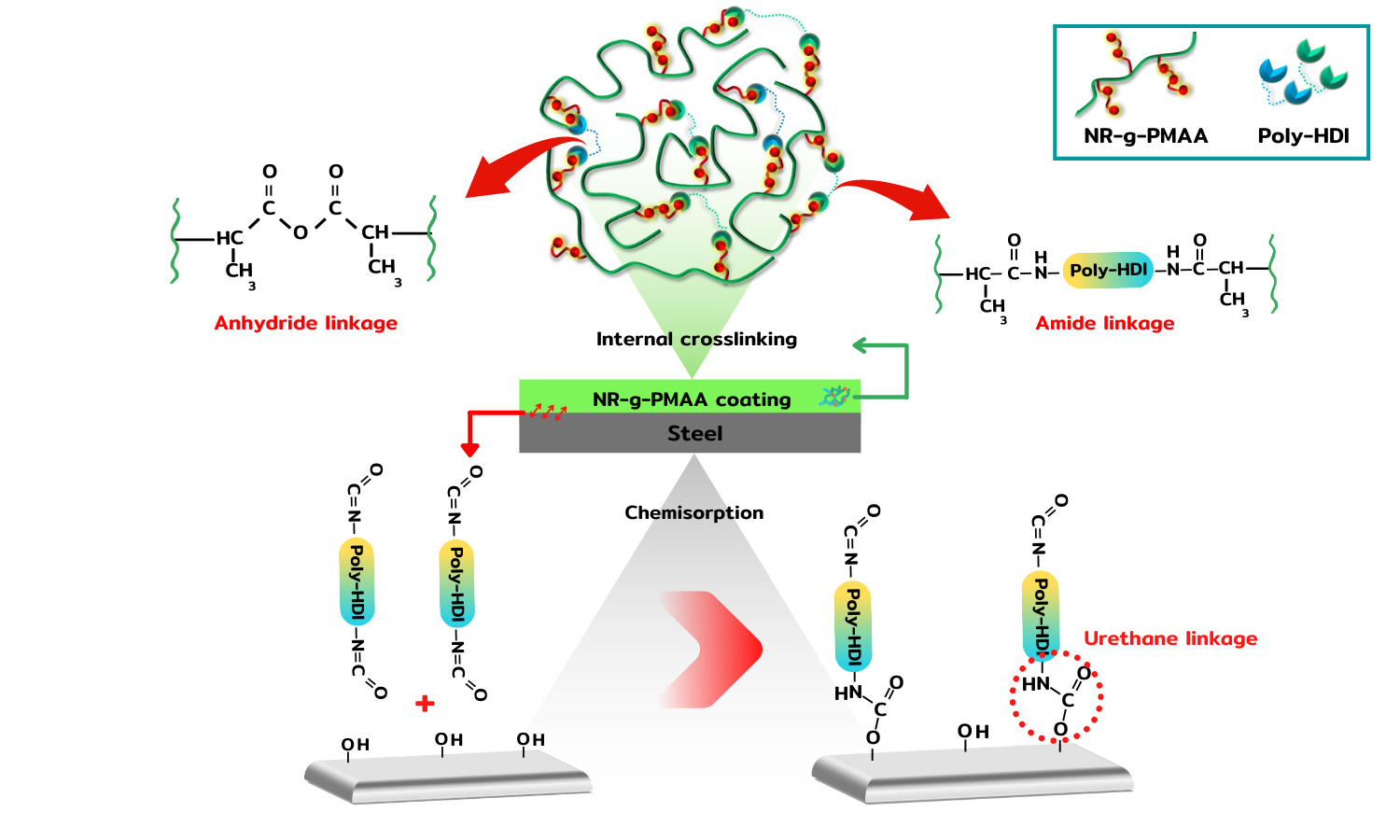
This study aimed to develop an anti-corrosion primer for steel based on natural rubber (NR). Graft copolymers of NR and poly(methacrylic acid), NR-g-PMAA, were first synthesized using a solution polymerization technique. The degree of grafting of poly(methacrylic acid) in NR-g-PMAA was evaluated by the 1H-NMR technique. The primer was then prepared by compounding the synthesized NR-g-PMAA with colour pigment and isocyanate crosslinking agent (poly-HDI). The X-ray photoelectron spectroscopy analysis indicated the formation of amide and anhydride linkages in the NR-g-PMAA primer by reaction with poly-HDI under ambient conditions. The cross-cut and salt-spray tests suggested that good adhesion of the primer to the steel was achieved by adding a 2:1 molar ratio of poly-HDI:MAA. The addition of poly-HDI to the NR-g-PMAA primer also significantly improved its weathering resistance. No rust deposits formed on the steel coated with the cured primer after 500 h of exposure in a QUV Accelerated Weathering tester. In contrast, a layer of iron oxide formed over the steel coated with the uncured primer, indicating that it corroded during testing. The X-ray diffraction analyses revealed that the iron oxides formed under the experimental conditions were dominantly lepidocrocite and goethite. Hence, it can be stated that when the NR-g-PMAA primer is formulated in conjunction with an appropriate amount of poly-HDI, it offers the potential to develop an anti-rust primer for steel.
Imran Oral, Mursel Ekrem
Vol. 16., No.6., Pages 591-606, 2022
DOI: 10.3144/expresspolymlett.2022.44
Vol. 16., No.6., Pages 591-606, 2022
DOI: 10.3144/expresspolymlett.2022.44
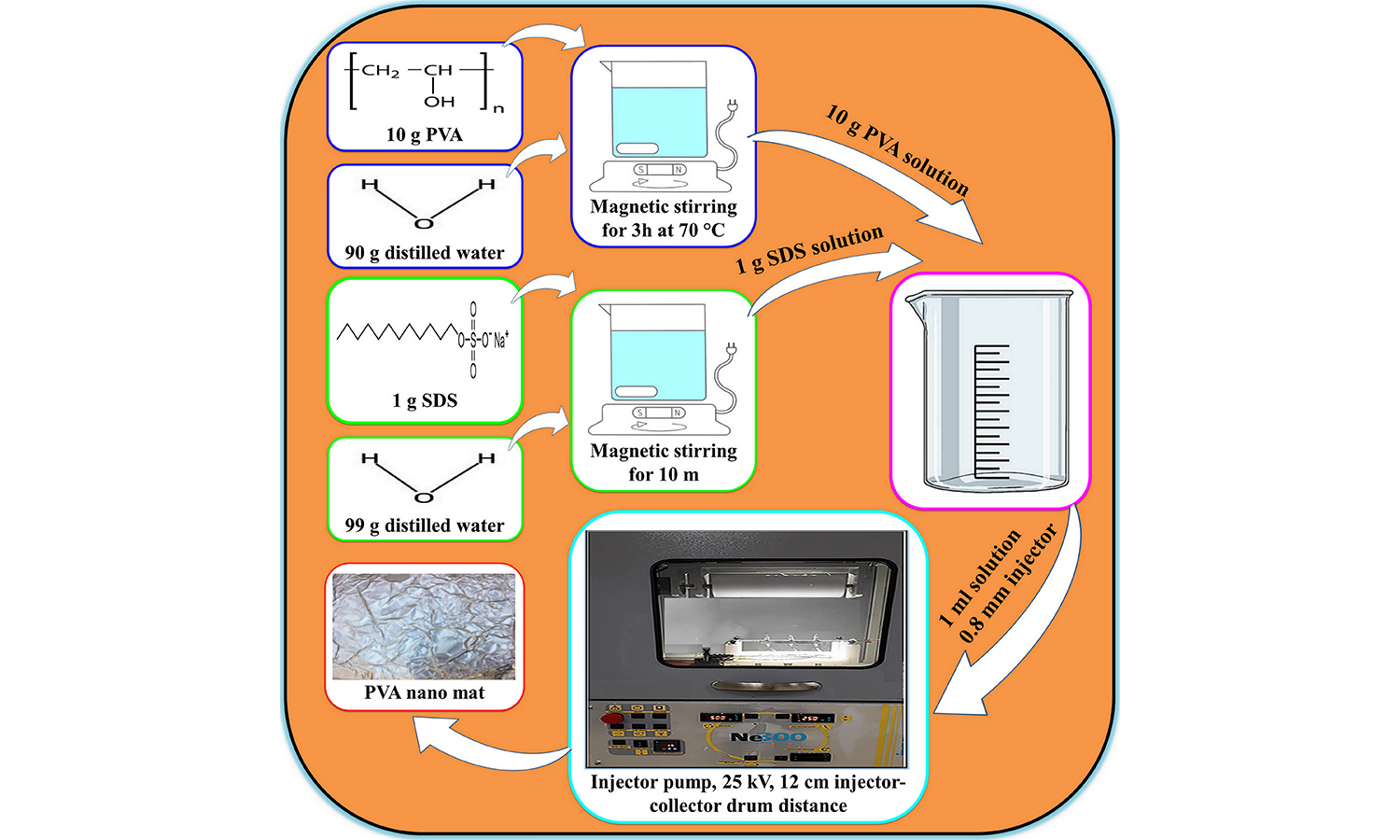
The polyvinyl alcohol (PVA) nanofiber mats are produced using the electrospinning method. The epoxy resin (ER)/polyvinyl alcohol (PVA) nanocomposites are obtained by adding PVA nanofiber mats into neat epoxy resin (ER) as 5, 10, and 15 layers. The elastic properties (elastic constants, Young’s modulus, Poisson’s ratio, and Shear modulus) of the neat ER, and the ER/PVA nanocomposites, are determined by ultrasonic longitudinal wave velocity (VL) and shear wave velocity (VS) measurements. The morphology of the neat ER and the ER/PVA nanocomposites is investigated using scanning electron microscopy (SEM). The results obtained from SEM images showed the ER/PVA nanocomposites have a transversely isotropic structure. The VL value of isotropic neat ER was obtained higher than the value of VL33 and VL45° but lower in x(1) direction for VL11 in the ER/PVA nanocomposites. The velocity values of ultrasonic shear waves propagated in x(1) direction and polarized in y(2) direction in the ER/PVA nanocomposites are determined as higher than the velocity values of ultrasonic shear waves propagated in z(3) and polarized in x(1) direction. Also, the value of E3 determined in the z(3) direction is found to be significantly higher than the value of E1 determined in the x(1) direction when the number of PVA layers increased in the ER matrix. The value of shear modulus (G31) is found as 1.53, 1.76, and 1.61 GPa for the ER/PVA-5, the ER/PVA-10, and the ER/PVA-15, respectively. The Poisson’s ratio values of the ER/PVA nanocomposites are determined as between 0.473–0.502 and 0.247–0.276 for μ11 and μ31, respectively. On the other hand, the degree of anisotropy in the ER/PVA nanocomposites is determined using ratios of E1/E3 and μ11/μ31. A small degree of anisotropy in dynamic Young’s modulus (0.93–0.99) is observed, while a higher ratio is observed for Poisson’s ratio (1.71–2.03) with increasing PVA layers in neat ER.
Artjima Ounkaew, Pornnapa Kasemsiri, Natnaree Srichiangsa, Kaewta Jetsrisuparb, Jesper T. N. Knijnenburg, Manunya Okhawilai, Salim Hiziroglu, Somnuk Theerakulpisut
Vol. 16., No.6., Pages 607-623, 2022
DOI: 10.3144/expresspolymlett.2022.45
Vol. 16., No.6., Pages 607-623, 2022
DOI: 10.3144/expresspolymlett.2022.45
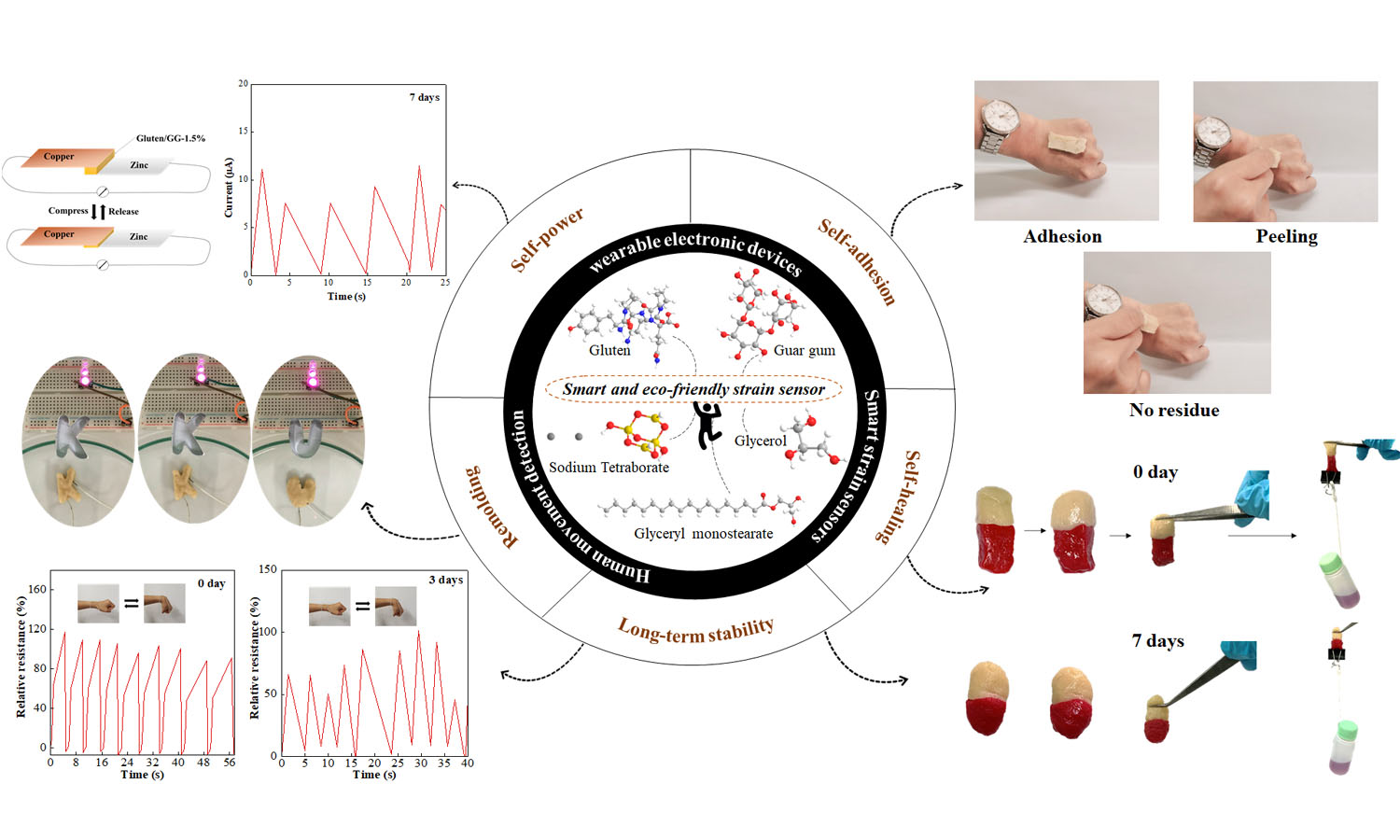
In this research, a multifunctional strain sensor based on gluten/guar gum (GG) copolymer was developed. The effects of gluten/GG blended ratios on the mechanical and electrical properties, self-adhesion, self-healing, remolding, selfpowered and long-term stability of the strain sensors were studied. Among tested substrates, the gluten/GG blend indicated a strong adhesion to wood and paper substrates and showed a maximum adhesive strength at 1.5 wt% of GG in the copolymer (gluten/GG-1.5%). The adhesive strength of gluten/GG-1.5% decreased in the acceptable range when it was applied in 10 repeated adhesion cycles. The gluten/GG-1.5% exhibited a high electrical conductivity of 0.12 S/m and stretchability of 465%. The gluten/GG-based sensor containing glycerol showed long-term stability of self-healing, remolding, and self-powered ability when stored for 7 days, whereas the self-adhesive ability decreased with increasing storage time. The self-adhesive gluten/GG-1.5% was used to monitor human limb movements, which showed remarkable sensitivity during the storage time of 3 days. Such properties suggested a potential use of smart strain sensors with multifunctional capabilities for applications in wearable electronic devices.
Muhammad Yasir, Tomas Sopik, Rahul Patwa, Dusan Kimmer, Vladimir Sedlarik
Vol. 16., No.6., Pages 624-648, 2022
DOI: 10.3144/expresspolymlett.2022.46
Vol. 16., No.6., Pages 624-648, 2022
DOI: 10.3144/expresspolymlett.2022.46
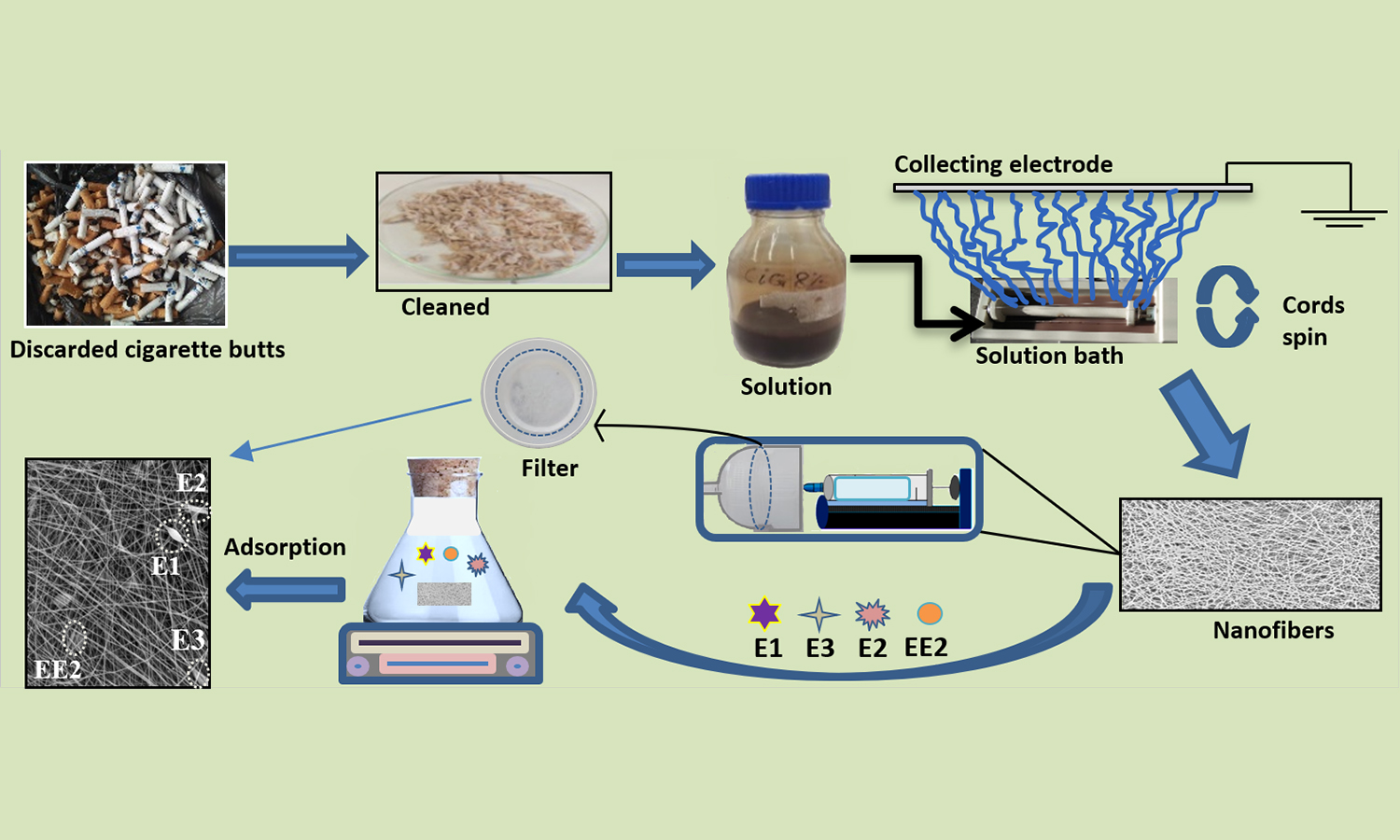
This study emphasizes rapid and simultaneous adsorptive removal of estrogenic hormones (EH): estrone (E1), estradiol (E2), ethinylestradiol (EE2), and estriol (E3) from wastewater using recycled waste cigarette electrospun fibers (WCENFs). The submicron fibers exhibited a strong affinity towards all EH due to abundant hydrogen bonding interactions. The adsorption kinetics pseudo-first-order, pseudo-second-order, intra-particle diffusion, Elovich, and fractional power models were explored and fitted towards optimum conditions for the large-scale removal process of the EH. Results showed that E1, E2, and EE2 followed pseudo-second-order kinetics while E3 followed the pseudo-first-order kinetic model. In combination, the total adsorption capacity achieved was 2.14 mg/g, whereas the individual values for E1, E2, EE2, and E3 were 0.551, 0.532, 0.687, and 0.369 mg/g, respectively. The percentage efficiency of WCENFs was highest with EE2 ~64.3% and least with E3 ~34.6%. The WCENFs could repeatedly be used for four adsorption-desorption cycles as an effective adsorbent for the simultaneous removal of four EH via batch adsorption studies. According to the results obtained, the repurposing of waste cigarette butts to WCENFs presented itself as a suitable alternative for removing EH and possibly other organic pollutants from water.
Amin Raveshtian, Mohammad Fasihi, Reza Norouzbeigi, Sajad Rasouli
Vol. 16., No.6., Pages 649-664, 2022
DOI: 10.3144/expresspolymlett.2022.47
Vol. 16., No.6., Pages 649-664, 2022
DOI: 10.3144/expresspolymlett.2022.47
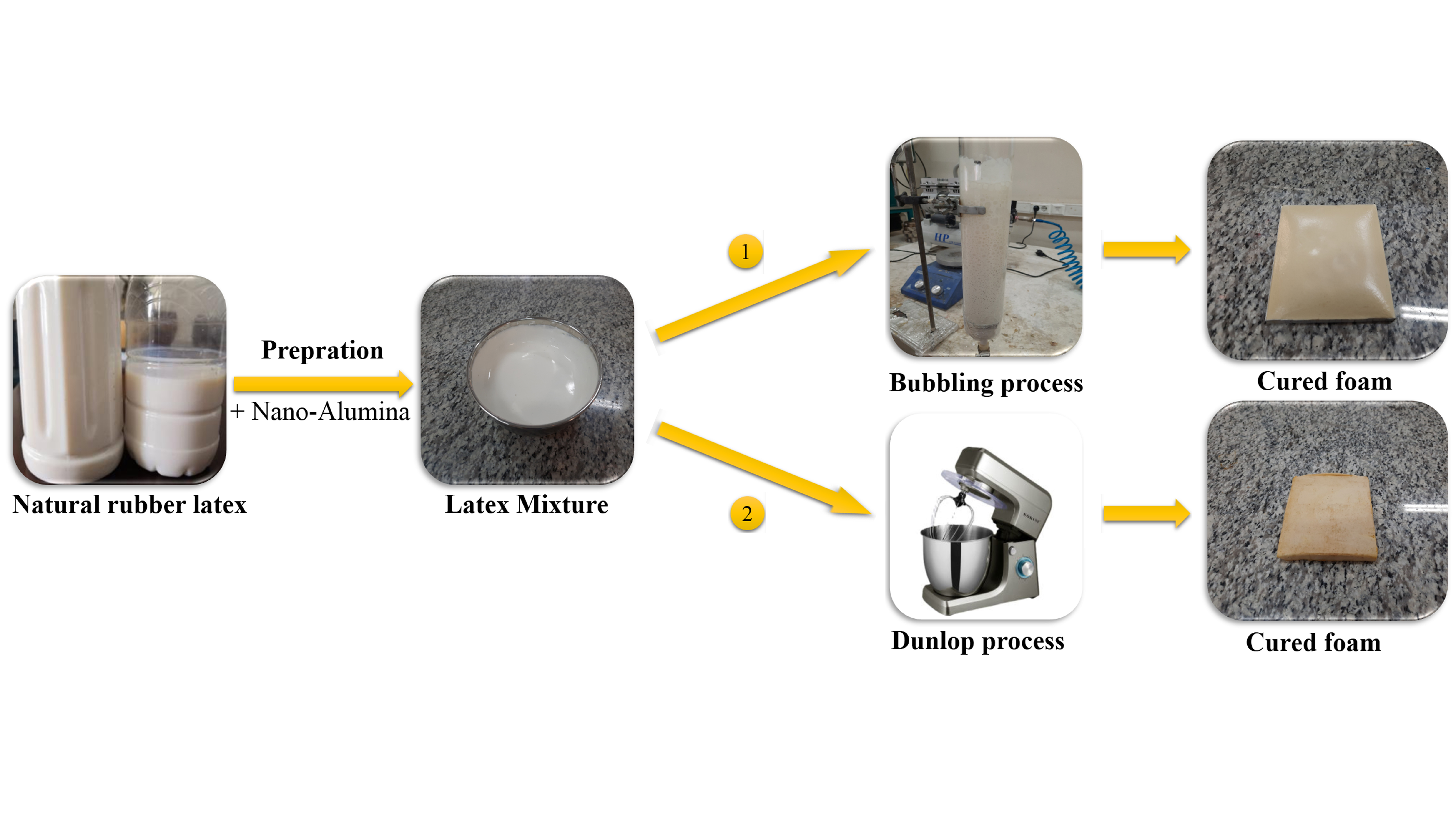
The impacts of nano-alumina (NA) as a filler and the manufacturing methods of Dunlop and air microbubbling on the physical, microstructural and mechanical properties of natural rubber latex foam (NRLF) were comprehensively investigated. The achieved crosslink density through the swelling method using the Flory–Rehner equation showed that the nano-alumina led to an increase in the crosslinking level in the foam. The foams prepared by the air microbubbling (BLF) had crosslink density 57–160% more than Dunlop (LF). Despite the fact that the nano-alumina enhanced the cell size and broadened their diameters probability distribution, the field-emission scanning electron microscopy illustrated that the air microbubbling resulted in the foams with 105% smaller cell size (0.113 mm) and 840% higher cell density (57.94·105 cell/mm3). In addition, the calculated specific tensile strength, modulus, toughness, and elongation at break proved that the metallic oxide filler of nano-alumina improved the tensile characteristics of the NRLF up to 60%. According to the results, adding 3 phr nano-alumina to the foam increased the compression recovery to 86 and 99.4% in the LF and BLF samples, respectively. Finally, the analysis of variance was performed to optimize the formulation of foams prepared by two manufacturing methods.
Xitao Yang, Haoqun Hong, Haiyan Zhang, Xiaobin Hong
Vol. 16., No.6., Pages 665-676, 2022
DOI: 10.3144/expresspolymlett.2022.48
Vol. 16., No.6., Pages 665-676, 2022
DOI: 10.3144/expresspolymlett.2022.48
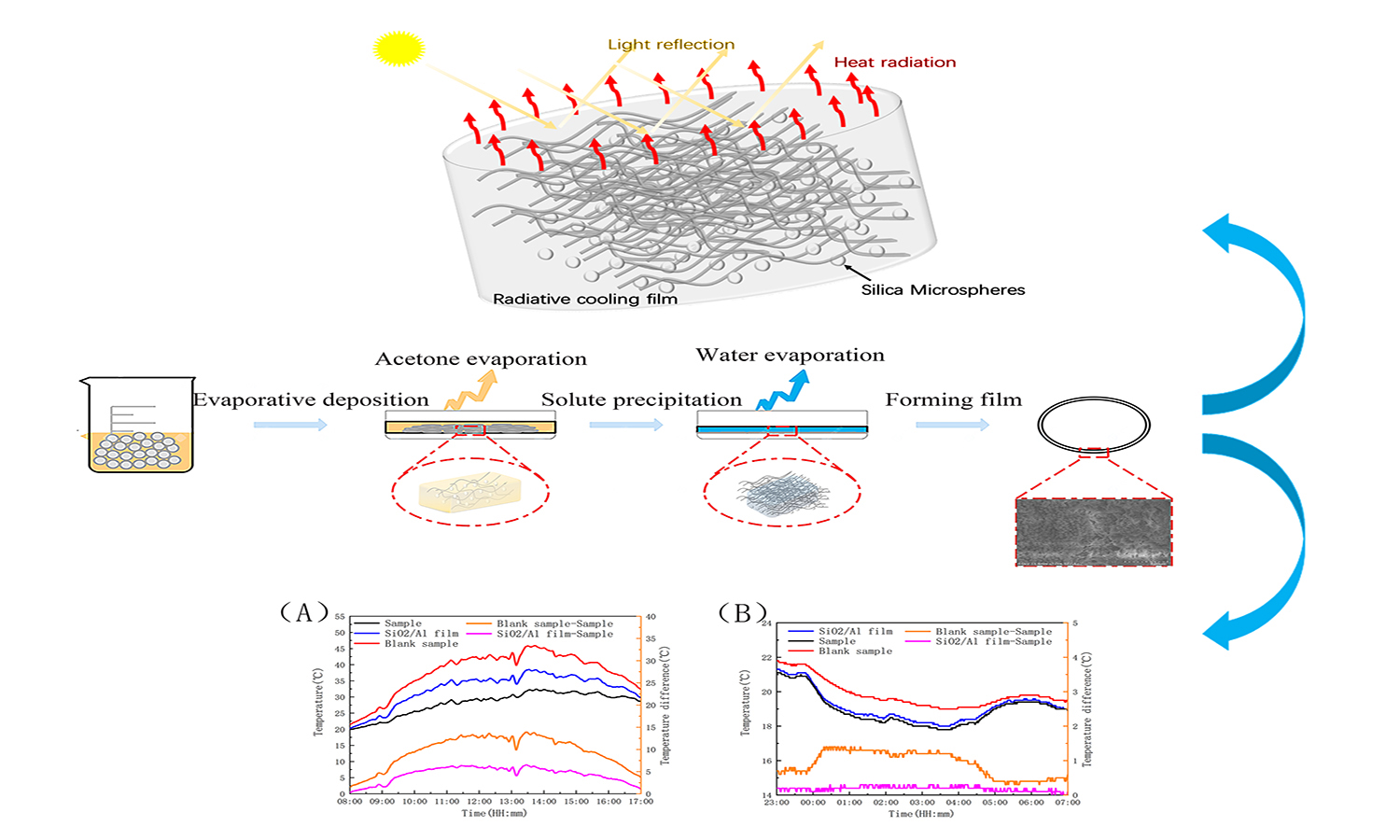
Passive radiative cooling is a key technology to solve the global warming and energy waste caused by refrigeration. However, because of the high price and complex manufacturing process, the application of daytime radiative cooling materials in the field of building materials is hindered. Here, we studied a low-cost radiative cooling cellulose-based composite material prepared from wood powder that exhibits highly selective infrared emission and high solar reflectivity. And we use the evaporation deposition technique to form a dual-layer structure with silica microspheres in the lower layer. The radiative cooling film based on the intrinsic absorption of lignocellulose and silica microspheres exhibits not only high infrared emissivity of 98.7% in the ‘atmospheric window’ range but also exhibits high reflectivity of 98.44% in the visible light range. We have also found that the performance of the radiative cooling film is the best when the content of silica microspheres reaches 30 wt%, and the film exhibits a cooling of 9.6 °C under direct sunlight. The preparation method of low-cost and high-performance radiative cooling material provided in this article is expected to provide a reference for the application of radiative cooling materials in building materials.


